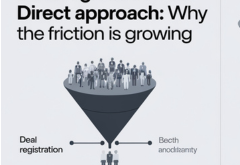The technology channel is in the midst of a transformation. By 2026, the role of partners has moved far beyond pushing vendor products into the market. CIOs, analysts, and channel leaders all point to the same trend: partners are becoming co-creators, delivering customer-defined outcomes instead of vendor-dictated sales.
For enterprise technology leaders, the expectation is clear—partners must help solve business problems. Stefano Bombara, Head of Technical Systems at Crédit Agricole Vita, explained it bluntly: “CIOs don’t want a partner who simply settles for a supply contract. Instead, the vendor must constantly offer new solutions for technologies, use cases, and methodological approaches. It’s in these processes that we expect proactivity.” This demand for deeper engagement is echoed across geographies. Shane McDaniel, CIO of the City of Seguin, Texas, noted: “It’s not just a transactional relationship… It’s a true partner.” McDaniel praised a vendor that went beyond contractual terms to help his city achieve strategic goals—proof that CIOs value outcomes, not one-off sales.
Similarly, Parm Sandhu, CIO at ISSofBC in Canada, said the vendor selection process is no longer just about products. “It involves opening up my strategy, my vision, and my aspirations to the vendor so they can act as partners and advisors in meeting unique business needs. The more they understand what we’re doing… and where we want to get to, the better equipped they are to help us on that journey.”
Industry analysts confirm the shift toward customer-first models. Anuj Singhal founder and Chief Analyst, urges partners to rethink their role: “Forget the ‘trusted advisor’ moniker; become a ‘success partner’ because shared risk agreements are reshaping the channel landscape.” Anuj notes that more than 45% of channel firms now describe their approach as outcome-focused or shared-risk, tying payments to customer results. Ted Schadler, VP & Principal Analyst at Forrester Research, highlights co-innovation as the new benchmark: “Leading firms develop advanced partner strategies that focus on outcomes, share risk, align incentives to motivate all parties, and work in blended teams to achieve better results.” According to Schadler, every company can adopt this model to co-create value with partners.
On the ground, channel leaders are seeing the same pressure. Jesse Grindeland, VP of Global Channels & Alliances at Skyhigh Security, observed: “The days of vendors and VARs thriving purely on transactional efficiency are numbered. Buyers don’t just want a product; they want partners who understand their business, align with their strategic goals, and fill critical skill gaps.” He added that vendors and resellers alike must reposition as trusted advisors and solution providers.
Channel consultant and author Hans Peter Bech summarized the modern mandate: “The job of the channel partner is to find, win, make, keep and grow happy customers.” His view underlines that long-term growth comes from solving customer problems and delivering outcomes, not just meeting vendor quotas.
Each of these voices CIOs, analysts, and channel executivesalign on a single message: the channel must pivot to a customer-led, outcome-oriented approach. Instead of pushing the latest hardware or software, successful partners in 2026 are those who co-create solutions, invest in understanding client businesses, and commit to delivering tangible results. The partner of the AI era is not a vendor mouthpiece. They are the customer’s advocate, co-innovator, and trusted advisor. The shift away from vendor-driven sales models is now irreversible, and those who fail to adapt risk irrelevance.
Quote Courtsey: CIO dotcom|
 Latest Technology News Today – Get Latest Information Technology Updates and Services Latest Technology News Today – Get Latest Information Technology Updates and Services
Latest Technology News Today – Get Latest Information Technology Updates and Services Latest Technology News Today – Get Latest Information Technology Updates and Services 









